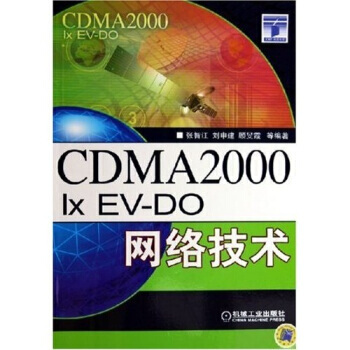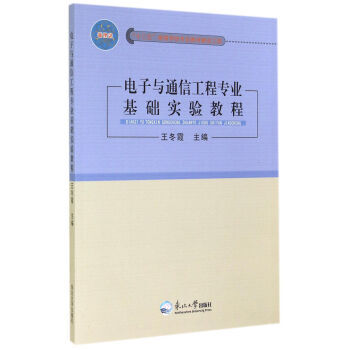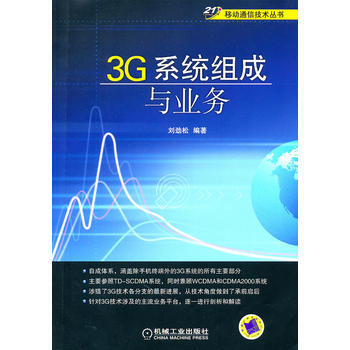

具体描述
基本信息
书名:数字通信(第五版 英文精简版)
定价:59.00元
作者:(美)普罗科斯,(美)萨利希,张力军 等改编
出版社:电子工业出版社
出版日期:2012-01-01
ISBN:9787121153259
字数:
页码:
版次:1
装帧:平装
开本:
商品重量:0.4kg
编辑推荐
内容提要
本书是在《数字通信(第五版)》的基础上,根据的实际教学情况进行精简和改编的。主要的精简原则为:保留信号传输理论内容,舍去信息传输理论内容,并以传统而经典的数字传输理论为主,无线通信为辅。改编的部分主要是根据实际教学的常用习惯来进行的。精简后的内容主要涵盖:确定与*信号分析;数字调制方法;AWGN信道的*接收机;载波和符号同步;通过带限信道的数字通信;自适应均衡;多信道和多载波系统;数字通信用扩频信号;衰落信道:信道特征与信号传输;多天线系统。
目录
Chapter 1Introduction
1.1 Elements of a Digital CommunicationSystem
1.2 Communication Channels and TheirCharacteristics
1.3 Mathematical Models for CommunicationChannels
1.4 A Historical Perspective in the Development of
Digitalommunications
Chapter 2 Deterministic and Random SignalAnalysis
2.1 Representation of Bandpass Signals andSystems
2.1–1 Representation of Bandpass Signals/ 2.1–2 Response of aBandpass System to a Bandpass Signal
2.2 Signal Space Representation ofWaveforms
2.2–1 Vector Space Concepts / 2.2–2 Signal Space Concepts / 2.2–3Orthogonal Expansions of Signals /2.2–4 Gram-SchmidtProcedure
2.3 Some Useful RandomVariables
2.4 RandomProcesses
2.4–1 Wide-Sense Stationary Random Processes /2.4–2Cyclostationary Random Processes
2.5 Series Expansion of RandomProcesses
2.5–1 Sampling Theorem for Band-Limited RandomProcesses /2.5–2 TheKarhunen-Lo`eve Expansion
2.6 Bandpass Stationary StochasticProcesses
Problems
Chapter 3 Digital ModulationSchemes
3.1 Representation of Digitally ModulatedSignals
3.2 Memoryless ModulationMethods
3.2–1 Pulse Amplitude Modulation (PAM) / 3.2–2 Phase Modulation /3.2–3 Quadrature Amplitude Modulation /3.2–4 MultidimensionalSignaling
3.3 Signaling Schemes withMemory
3.3–1 Continuous-Phase Frequency-Shift Keying(CPFSK) /
3.3–2 Continuous-Phase Modulation (CPM)
3.4 Power Spectrum of Digitally ModulatedSignals
3.4–1 Power Spectral Density of a Digitally ModulatedSignalwith
Memory / 3.4–2 Power Spectral Density of LinearlyModulated
Signals / 3.4–3 Power Spectral Density ofDigitally Modulated
Signals with Finite Memory / 3.4–4Power Spectral Density of
Modulation Schemes with a MarkovStructure / 3.4–5 Power
Spectral Densities of CPFSK and CPM Signals
Problems
Chapter 4 Optimum Receivers for AWGNChannels
4.1 Waveform and Vector ChannelModels
4.1–1 Optimal Detection for a General Vector Channel
4.2 Waveform and Vector AWGNChannels
4.2–1 Optimal Detection for the Vector AWGN Channel /4.2–2Implementation of the Optimal Receiver for AWGN Channels / 4.2–3 AUnion Bound on the Probability of Error of Maximum LikelihoodDetection
4.3 Optimal Detection and Error Probability for Band-Limited
Signaling
4.3–1 Optimal Detection and Error Probability for ASK or
PAM Signaling / 4.3–2 Optimal Detection and ErrorProbability
for PSK Signaling / 4.3–3 Optimal Detection and ErrorProbability
for QAM Signaling / 4.3–4 Demodulation and Detection
4.4 Optimal Detection and Error Probability forPower-Limited
Signaling
4.4–1 Optimal Detection and Error Probability for Orthogonal
Signaling / 4.4–2 Optimal Detection and Error Probabilityfor
Biorthogonal Signaling / 4.4–3 Optimal Detection and Error
Probability for Simplex Signaling
4.5 Optimal Detection in Presence of Uncertainty:Noncoherent
Detection
4.5–1 Noncoherent Detection of Carrier Modulated Signals /4.5–2Optimal Noncoherent Detection of FSK Modulated Signals / 4.5–3Error Probability of Orthogonal Signaling with NoncoherentDetection / 4.5–4 Probability of Error for Envelope Detection ofCorrelated Binary Signals /4.5–5 Differential PSK (DPSK)
4.6 A Comparison of Digital SignalingMethods
4.6–1 Bandwidth and Dimensionality
4.7 Lattices and Constellations Based onLattices
4.7–1 An Introduction to Lattices / 4.7–2 Signal Constellationsfrom Lattices
4.8 Detection of Signaling Schemes withMemory
4.8–1 The Maximum Likelihood Sequence Detector
4.9 Optimum Receiver for CPMSignals
4.9–1 Optimum Demodulation and Detection of CPM /4.9–2 Performanceof CPM Signals / 4.9–3 Suboptimum Demodulation and Detection of CPMSignals
Problems
Chapter 5 Carrier and SymbolSynchronization
5.1 Signal ParameterEstimation
5.1–1 The Likelihood Function / 5.1–2 Carrier Recovery and
Symbol Synchronization in Signal Demodulation
5.2 Carrier PhaseEstimation
5.2–1 Maximum-Likelihood Carrier Phase Estimation /5.2–2 ThePhase-Locked Loop / 5.2–3 Effect of AdditiveNoise on the PhaseEstimate / 5.2–4 Decision-Directed Loops / 5.2–5Non-Decision-Directed Loops
5.3 Symbol TimingEstimation
5.3–1 Maximum-Likelihood Timing Estimation /5.3–2Non-Decision-Directed Timing Estimation
5.4 Joint Estimation of Carrier Phase and SymbolTiming
5.5 Performance Characteristics of MLEstimators
Problems
Chapter 6 Digital Communication Through Band-LimitedChannels
6.1 Characterization of Band-LimitedChannels
6.2 Signal Design for Band-LimitedChannels
6.2–1 Design of Band-Limited Signals for No Intersymbol
Interference—The Nyquist Criterion / 6.2–2 Design of Band-LimitedSignals with Controlled ISI—Partial-Response Signals / 6.2–3 DataDetection for Controlled ISI /6.2–4 Signal Design for Channels withDistortion
6.3 Optimum Receiver for Channels with ISI andAWGN
6.3–1 Optimum Maximum-Likelihood Receiver /6.3–2 A Discrete-TimeModel for a Channel with ISI /6.3–3 Maximum-Likelihood SequenceEstimation (MLSE)
for the Discrete-Time White Noise Filter Model
6.4 LinearEqualization
6.4–1 Peak Distortion Criterion /6.4–2 Mean-Square-Error (MSE)Criterion /
6.4–3 Performance Characteristics of the MSE Equalizer /6.4–4Fractionally Spaced Equalizers /6.4–5 Baseband and Passband LinearEqualizers
6.5 Decision-FeedbackEqualization
6.5–1 Coefficient Optimization /6.5–2 Performance Characteristicsof DFE
6.6 Reduced Complexity MLDetectors
Problems
Chapter 7 AdaptiveEqualization
7.1 Adaptive LinearEqualizer
7.1–1 The Zero-Forcing Algorithm /7.1–2 The LMS Algorithm /7.1–3Convergence Properties of the LMS Algorithm /7.1–4 Excess MSE dueto Noisy Gradient Estimates /7.1–5 Accelerating the InitialConvergence Rate
in the LMS Algorithm / 7.1–6 Adaptive Fractionally SpacedEqualizer—The Tap Leakage Algorithm /7.1–7 An Adaptive ChannelEstimator for ML
Sequence Detection
7.2 Adaptive Decision-FeedbackEqualizer
7.3 Recursive Least-Squares Algorithms for AdaptiveEqualization
7.3–1 Recursive Least-Squares (Kalman) Algorithm /7.3–2 LinearPrediction and the Lattice Filter
Problems
Chapter 8 Multichannel and MulticarrierSystems
8.1 Multichannel Digital Communications in AWGNChannels
8.1–1 Binary Signals / 8.1–2 M-ary Orthogonal Signals
8.2 MulticarrierCommunications
8.2–1 Single-Carrier Versus Multicarrier Modulation /8.2–2Capacity of a Nonideal Linear Filter Channel /8.2–3 OrthogonalFrequency Division Multiplexing (OFDM) /8.2–4 Modulation andDemodulation in an OFDM System /
8.2–5 An FFT Algorithm Implementation of an OFDM System /8.2–6Spectral Characteristics of Multicarrier Signals /8.2–7 Bit andPower Allocation in Multicarrier Modulation /8.2–8 Peak-to-AverageRatio in Multicarrier Modulation /8.2–9 Channel CodingConsiderations in Multicarrier Modulation
Problems
Chapter 9 Spread Spectrum Signals for DigitalCommunications
9.1 Model of Spread Spectrum Digital CommunicationSystem
9.2 Direct Sequence Spread SpectrumSignals
9.2–1 Error Rate Performance of the Decoder /9.2–2 SomeApplications of DS Spread Spectrum Signals /9.2–3 Effect of PulsedInterference on DS Spread Spectrum Systems / 9.2–4 Excision ofNarrowband Interference in DS Spread Spectrum Systems / 9.2–5Generation of PN Sequences
9.3 Frequency-Hopped Spread SpectrumSignals
9.3–1 Performance of FH Spread Spectrum Signals in an
AWGN Channel / 9.3–2 Performance of FH Spread Spectrum
Signals in Partial-Band Interference / 9.3–3 A CDMA System
Based on FH Spread Spectrum Signals
9.4 Other Types of Spread SpectrumSignals
Problems
Chapter 10 Fading Channels : Characterization and
Signaling
10.1 Characterization of Fading MultipathChannels
10.1–1 Channel Correlation Functions and Power Spectra /
10.1–2 Statistical Models for Fading Channels
10.2 The Effect of Signal Characteristics on the Choice of aChannelModel
10.3 Frequency-Nonselective, Slowly FadingChannel
10.4 Diversity Techniques for Fading MultipathChannels
10.4–1 Binary Signals / 10.4–2 Multiphase Signals /10.4–3 M-aryOrthogonal Signals
10.5 Signaling over a Frequency-Selective, Slowly FadingChannel:
The RAKEemodulator
10.5–1 A Tapped-Delay-Line Channel Model / 10.5–2 The RAKEDemodulator / 10.5–3 Performance of RAKE Demodulator / 10.5–4Receiver Structures for Channels with IntersymbolInterference
10.6 Multicarrier Modulation(OFDM)
10.6–1 Performance Degradation of an OFDM System due to DopplerSpreading / 10.6–2 Suppression of ICI in OFDM Systems
Problems
Chapter 11 Multiple-AntennaSystems
11.1 Channel Models for Multiple-AntennaSystems
11.1–1 Signal Transmission Through a Slow FadingFrequency-Nonselective MIMO Channel / 11.1–2 Detection of DataSymbols in a MIMO System / 11.1–3 Signal
Transmission Through a Slow Fading Frequency-Selective MIMOChannel
11.2 Spread Spectrum Signals and MulticodeTransmission
11.2–1 Orthogonal Spreading Sequences /11.2–2 Multiplexing GainVersus Diversity Gain /11.2–3 Multicode MIMO Systems
Problems
作者介绍
文摘
序言
用户评价
这本书的结构安排,如同一个技艺精湛的工匠在打磨一块璞玉,层层递进,逻辑链条严密得让人喘不过气,但同时也让人欲罢不能。它避开了那些市场上流行的,过于偏重软件实现或最新协议的潮流风向,而是将火力集中在那些真正决定性能上限的底层物理过程上。比如,对于信道编码和调制的论述,它不是简单地罗列出MPSK、QAM等调制方式的星座图,而是深入挖掘了它们在不同噪声环境下误码率的数学边界,以及如何通过更复杂的编码方案去逼近香农极限。我花了整整一个下午去啃第五章关于均衡技术的章节,作者用极其精妙的笔触,阐述了判决反馈均衡(DFE)和迫零(ZF)均衡器的工作原理及其在实际多径信道中的局限性。书中对于信道模型的假设非常清晰,从理想的AWGN到复杂的衰落信道,每一步的过渡都伴随着精确的数学模型建立。这种由浅入深,层层剥茧的讲解方式,极大地培养了读者的“系统思维”——你不再是孤立地看一个算法,而是能清晰地看到它在整个通信链路中扮演的角色和受到的制约。那种清晰的脉络感,使得复杂的理论知识点不再是零散的碎片,而是有机地组合成了一张密不透风的理论大网。
评分这本书的语言风格,用一个词来形容就是“克制而有力”。它很少使用煽动性的语言,更没有那种试图用时髦概念来吸引眼球的浮夸。整本书读下来,感觉就像是在听一位德高望重的学者用他最精确的词汇进行一次严谨的学术报告。每一个技术术语的定义都经过了反复的锤炼,力求准确无误。这种严谨性,在处理那些容易产生歧义的概念时尤为重要,比如“信息熵”和“互信息”的区分,书中通过明确的数学定义和清晰的物理意义阐释,彻底消除了我过去的一些模糊认识。相比于一些侧重工程应用的资料,这本书更像是一份理论蓝图的绘制指南。它迫使你必须调动起你所有关于微积分、概率论和线性代数的储备知识,去跟上作者的思路。坦白说,初读时,那种高强度的思考负荷让人倍感压力,经常需要停下来,反复咀嚼一两个段落才能真正消化。但正是这种高强度的思维对抗,带来了巨大的智力满足感。它不是在“喂”你知识,而是在训练你的“思考肌肉”,让你在面对新的通信技术挑战时,能够迅速地回到第一性原理上去进行分析和判断。
评分翻阅到后面章节,关于多址接入和频谱效率的探讨,体现了作者深厚的工程洞察力。尽管这本书的侧重点偏向理论基础,但它并没有脱离实际应用场景去空谈。比如,在介绍OFDM(正交频分复用)时,它没有停留在DFT/IDFT的数学形式上,而是巧妙地引入了循环卷积的概念,并解释了如何通过插入保护间隔(Guard Interval)来应对码间串扰(ISI)。这种将数学模型与物理信道特性紧密结合的叙述方式,对于理解现代无线通信系统的核心技术至关重要。更令人赞赏的是,书中对不同多址方案的优缺点分析非常中立且透彻,它会告诉你TDMA的优点在于低复杂度的同步,但缺点是频谱效率受限于时隙划分的精度;而CDMA的优势在于抗干扰能力,但其系统容量受限于近远效应和用户间干扰的精确控制。这种平衡的视角,让你在学习时不会陷入非此即彼的误区,而是能更全面地理解通信系统设计中的权衡艺术(Trade-off)。它教会我们的不是“什么是最好的”,而是“在特定约束下,什么是最优解”。
评分从整体阅读体验来看,这本书带给我最大的价值在于其强大的“知识锚定”能力。在如今碎片化学习盛行的时代,各种新技术名词层出不穷,但它们往往建立在一套相对固定的理论基石之上。这本书就像是一块坚实的基石,一旦你扎实地掌握了其中的概念,无论是面对5G的Massive MIMO,还是未来的太赫兹通信,你都能迅速地从底层原理去定位新技术的创新点和潜在瓶颈。它所蕴含的理论深度,使得我对许多看似高深的技术难题产生了“原来如此”的顿悟感。这本书的价值不在于它记录了最新的技术规范,而在于它教会了我们如何去理解和创造未来的规范。它更像是一本“内功心法”的秘籍,而非招式套路。对于真正想在通信领域深耕的人来说,这本书的价值会随着你专业知识的积累而不断增加,每一次重读,都会有新的理解和感悟。它用最简洁的篇幅,承载了最厚重的理论,是那种值得放在书架上,随时可以翻阅并从中汲取力量的经典之作。
评分这本书的封面设计简直是直击灵魂的朴实无华,那种带着些许陈旧感的字体排版,让我瞬间穿越回了那个胶片相机还流行,厚重教材是学习标配的年代。初次翻开,那份带着油墨香的纸张触感,以及那种微微泛黄的边角,无不透露着一种“硬货”的气息。它不像现在很多花里胡哨的教材那样堆砌大量的彩图和复杂的动画模拟,而是完全回归到了信息传输的本质。每一章的开篇,都不是那种拖泥带水的背景介绍,而是直截了当地抛出核心概念,仿佛一位经验丰富的老教授,不容许你有丝毫懈怠,直接把你拉入到那个充满傅里叶变换和噪声抑制的数学世界。尤其是那些推导过程,简直是教科书级别的严谨,每一个符号的出现都有其必然性,很少有那种“此处跳过”或者“读者自行推导”的含糊其辞。对于我这种热衷于从源头理解原理的人来说,这种扎实到近乎刻板的叙述方式,反而带来了一种极大的安全感。它没有试图用过于现代化的术语去粉饰理论的复杂性,而是用最经典、最经过时间检验的数学工具,把数字信号处理和信息论的基石夯筑得异常牢固。读下去,你会真切地感受到,这不仅仅是一本教材,更像是一部关于现代通信系统演化史的精炼史诗。
相关图书
本站所有内容均为互联网搜索引擎提供的公开搜索信息,本站不存储任何数据与内容,任何内容与数据均与本站无关,如有需要请联系相关搜索引擎包括但不限于百度,google,bing,sogou 等
© 2025 book.idnshop.cc All Rights Reserved. 静思书屋 版权所有




















